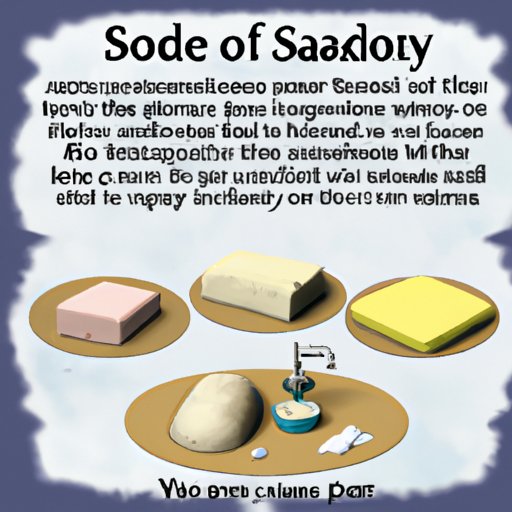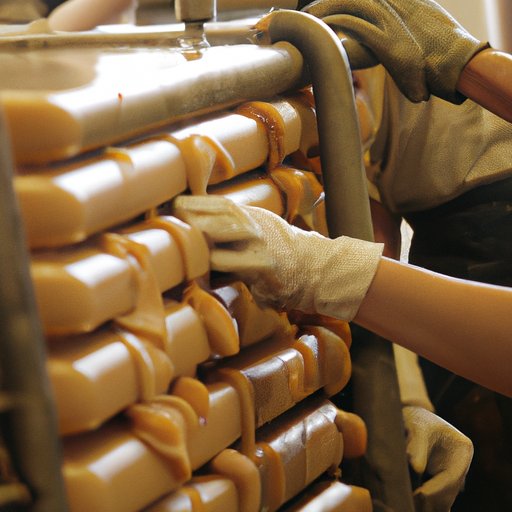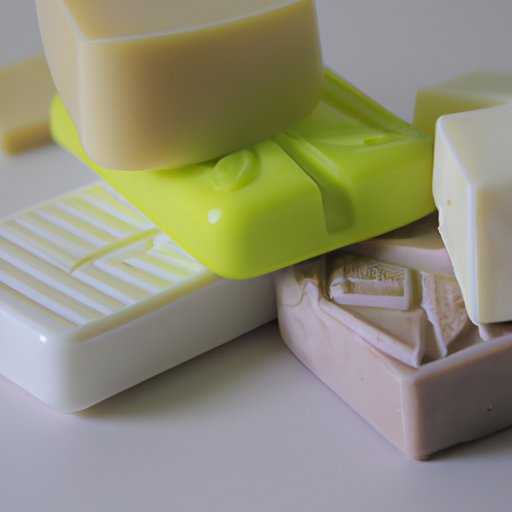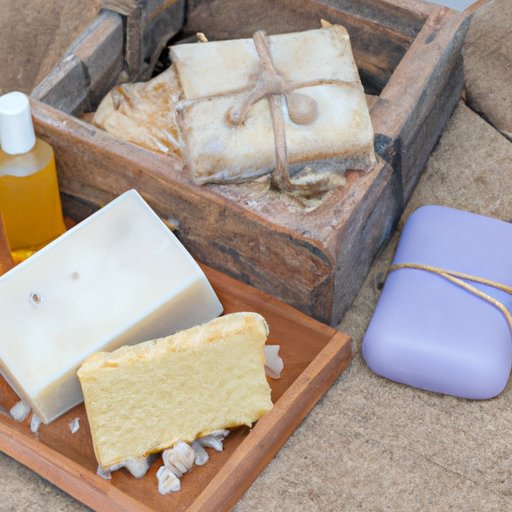Introduction
Soap is a product used for cleaning, typically made from fats or oils combined with an alkali such as lye. It is commonly used in households, businesses, and industries to clean and remove dirt, grease, and other contaminants. This article will explore how soap was invented and developed over time, as well as provide a comprehensive guide to the science behind soap production, the story of soap makers, the environmental impacts of soap manufacturing, and the benefits of using soap.

History of Soap: How it was Invented and Developed Over Time
The history of soap dates back thousands of years to ancient civilizations who used various forms of soap for cleaning purposes. Let’s take a look at some of the earliest uses of soap and how it evolved over time.
Early Uses of Soap
The earliest known evidence of soap-like substances dates back to 2800 BCE in ancient Babylon. These substances were created by combining ashes with animal fat and used to clean wool and cotton fabrics. Additionally, around 1500 BCE, the ancient Egyptians used a mixture of animal and vegetable oils with alkaline salts to create a kind of soap, which they used to clean their bodies and clothing.
The Ancient Egyptians
The ancient Egyptians are credited with being the first culture to use soap on a regular basis. They would combine animal and vegetable oils with alkaline salts to form a cleansing agent. The Egyptians used this soap as a hair dressing, body wash, and even to treat skin diseases.
The Romans
The Romans adopted the use of soap from the Egyptians. They would make a type of soap from goat’s tallow and ash, which they used for washing clothes and bathing. They also used a stronger version of the soap to clean statues and monuments.
The Middle Ages
During the Middle Ages, soap became more popular as a cleaning product. It was still made from animal and vegetable fats, but it now included other ingredients such as wood ash and potash. Soap was used for washing clothes, dishes, and even teeth. It was also used to treat skin conditions such as scabies and eczema.
The Industrial Revolution
The Industrial Revolution marked a major shift in the production of soap. With the introduction of new technologies, soap could be mass-produced and sold in stores. This allowed for a wider variety of soaps to be made, including those that were perfumed and colored. By the end of the 19th century, most households had access to soap.
A Comprehensive Guide to the Science Behind Soap Production
Soap is made by combining fats or oils with an alkali. This reaction is known as saponification, and it produces what is known as “soap molecules.” Let’s take a closer look at the science behind soap production.
Soap Ingredients
Soap is made up of three primary ingredients: fats or oils, an alkali, and water. Fats or oils provide the fatty acid chains that are needed for soap molecules to be formed. Alkalis, such as lye or sodium hydroxide, react with the fatty acids to produce the soap molecules. Finally, water is added to the mixture to help dissolve the ingredients and keep the soap in liquid form.
Soap Making Process
The process of making soap involves combining the fats or oils with the alkali in a specific ratio. This mixture is heated until it reaches a certain temperature, at which point the soap molecules are formed. Once the soap has cooled, it can be poured into molds and left to harden. The soap can then be cut into bars and packaged for sale.
The Role of Detergents
Detergents are substances that are similar to soap but are not made from natural ingredients. Instead, detergents are made from synthetic compounds such as surfactants, which are designed to reduce the surface tension of water and help it mix better with oils and dirt. Detergents are often used in place of soap because they are more effective at removing oil and dirt.
The Story of Soap Makers: Who Invented Soap?
While the exact origin of soap is unknown, it is believed that it was first made by ancient peoples who combined animal and vegetable fats with ashes. Let’s take a look at some of the earliest soap makers and how they influenced the industry.
Early Soap Makers
Some of the earliest known soap makers were the Babylonians, who likely combined animal fat with wood ashes to create a cleansing agent. The ancient Egyptians are also credited with creating a type of soap, which they used to clean their bodies and clothing. The Romans are believed to have been the first to mass-produce soap, which they made from goat’s tallow and wood ash.
Modern Soap Makers
Today, soap is made by combining fats or oils with an alkali such as lye. This process is known as saponification and produces soap molecules. Many modern soap makers use a variety of ingredients to create unique soaps, such as essential oils, herbs, and colors. Additionally, some soap makers specialize in creating soaps that are free from chemicals and other synthetic ingredients.

Exploring the Environmental Impacts of Soap Manufacturing
Soap production can have a negative impact on the environment if it is not done sustainably. Let’s take a look at some of the potential environmental impacts of soap manufacturing and how they can be minimized.
Pollution from Soap Production
The production of soap can result in the release of pollutants into the air, water, and soil. These pollutants can include volatile organic compounds, which can cause respiratory and other health problems. Additionally, the runoff from soap factories can pollute nearby water sources, leading to contamination of drinking water and aquatic habitats.
Sustainable Soap Making Practices
To minimize the environmental impacts of soap production, many soap makers are turning to sustainable practices. For example, some soap makers use renewable energy sources such as solar and wind to power their factories. Additionally, some soap makers are using natural ingredients such as essential oils and herbs, which are less likely to pollute the environment.
Benefits of Using Soap: Why We Need It
Soap is an important part of our everyday lives as it helps us stay clean and healthy. Here are some of the benefits of using soap.
Health Benefits of Soap
Using soap can help prevent the spread of germs and bacteria, which can lead to serious illnesses. According to a study published in the American Journal of Infection Control, handwashing with soap and water can reduce the risk of contracting diarrhea by up to 47%. Additionally, using soap can help reduce the risk of skin infections, as it helps remove dirt and other contaminants from the skin.
Cleanliness Benefits of Soap
Soap can also help keep surfaces and items clean. For example, soap can help remove dirt, grease, and other contaminants from dishes, clothes, and other items. Additionally, soap can help remove odors from fabrics and surfaces, making them smell fresher and cleaner.

A Look at the Different Types of Soap and Their Uses
There are several different types of soap available, each with its own unique properties and uses. Let’s take a look at some of the most common types.
Bar Soap
Bar soap is the most common type of soap and is typically made from fats or oils combined with an alkali such as lye. Bar soaps can be used for cleaning the body, hands, and face, as well as for washing dishes and laundry.
Liquid Soap
Liquid soaps are similar to bar soaps but are typically made with synthetic ingredients such as surfactants. Liquid soaps are often used as hand soaps, dish soaps, and laundry detergents.
Specialty Soaps
Specialty soaps are made with unique ingredients such as essential oils, herbs, and colors. These soaps are often used for their fragrances and skin care benefits. Examples include facial cleansers, body washes, and shampoos.
Conclusion
Soap has been used for centuries for its cleansing and health benefits. This article has explored the history of soap, from its early uses to its development over time. It also examined the science behind soap production, the story of soap makers, the environmental impacts of soap manufacturing, and the benefits of using soap. Additionally, we looked at the different types of soap and their uses. As you can see, soap is an important part of our everyday lives and its benefits should not be overlooked.
Further research could explore the sustainability of soap production and the ways in which soap makers can reduce their environmental impacts. Additionally, more research could be done on the health benefits of soap and the different types of soaps available.
(Note: Is this article not meeting your expectations? Do you have knowledge or insights to share? Unlock new opportunities and expand your reach by joining our authors team. Click Registration to join us and share your expertise with our readers.)
